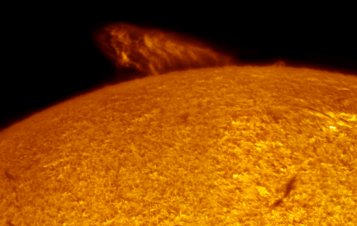 Planets. Comets. Auroras. Don't miss them! Sign up for Spaceweather PHONE.
Planets. Comets. Auroras. Don't miss them! Sign up for Spaceweather PHONE.
FIREBALL UPDATE: 300 tons of TNT. That's the kinetic energy of the meteoritic fireball sighted June 7th in Norway, according to Prof. Peter Brown of the University of Western Ontario. Brown's doctoral student, Wayne Edwards, arrived at this figure by analyzing infrasound and seismic data. Early reports of a Hiroshima-like event (12,000+ tons of TNT) were exaggerated.
 "An object like this hits Earth about once a month," notes Bill Cooke of the Marshall Space Flight Center. For comparison, "the Norwegian event was similar to, but somewhat less energetic than the Park Forest meteorite impact of 2003."
"An object like this hits Earth about once a month," notes Bill Cooke of the Marshall Space Flight Center. For comparison, "the Norwegian event was similar to, but somewhat less energetic than the Park Forest meteorite impact of 2003."
MEANWHILE IN POLAND: Earlier today, a meteorite or a piece of space junk reportedly struck a car in Poland: full story.
MARS IN THE BEEHIVE: Did a supernova go off in the Beehive star cluster? No, it's just the planet Mars:

Richard Nolthenius of Santa Cruz, California, caught Mars passing through the star cluster on June 15th. Mars has since left the Beehive; the red planet has another appointment--with Saturn! Tonight Mars and Saturn are side by side, eye-catchingly close together. Look for them in the western sky after sunset. Sky maps: June 16, June 17.
MASSIVE PROMINENCE: Got a solar telescope? Today would be a good day to use it. A massive prominence is sticking out from the sun's western limb, as shown in this picture from Gary Palmer of Los Angeles, California:

Prominences are clouds of hot hydrogen held above the surface of the Sun by magnetic force fields. Sometimes these clouds remain stable for days, slowly swaying back and forth, providing a leisurely show for onlookers. But if the magnetic fields become unstable--watch out. A prominence can collapse and explode with little warning. What will this one do? Stay tuned.

